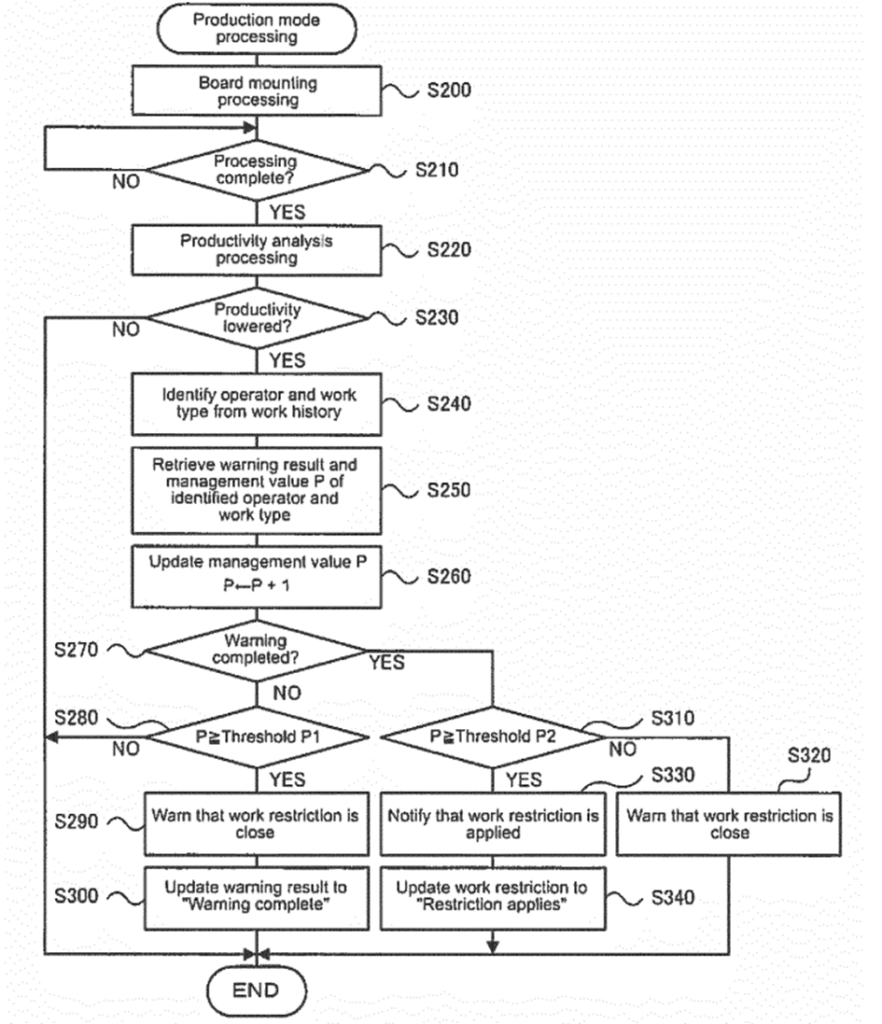EP 3 098 679 A1 filed as PCT/JP2014/051255 relates to a production system comprising a management computer allowing to restrict access to a human operator if its production is too low.

Brief outline of the case
The application was refused for lack of IS and the applicant appealed.
The board confirmed the refusal.
The applicant’s point of view
The applicant argued that the performance restriction in claim 1 was not a pure management decision. The restriction was individualised in the sense that it was explicitly limited to the operator who caused the lowered productivity of the production device, while all other operators were still able to perform production work on the production device.
A prerequisite for this was the storing and updating of individualised “performance information“, which was not available in known production systems. Without this information, an operator causing lowered productivity of the production device could not be identified and could consequently not be stopped from performing detrimental production work on the production device.
Thus, the claimed invention had the technical effect of improving the productivity of the production device by identifying an operator who caused a lowered productivity of the production device and by automatically applying a performance restriction only onto this identified operator while leaving the performance restrictions of all other operators unchanged.
Therefore, all the features in claim 1 should be regarded as technical features and should be considered relevant for assessing IS.
Since none of the prior art documents D1 to D3 discloses a performance restriction as in claim 1, claim 1 involved an IS.
The ED’s decision
The ED considered that claim 1 was a mix of technical and non-technical features and was therefore to be assessed according to the “Comvik approach” (see T 641/00 – Two identities/COMVIK).
The decision not to let an operator perform certain work because of their low performance in a production process was not considered to be a technical decision but rather a managerial one.
The technical features in claim 1 were the “memorizing means”, the means for restricting the use of the productions device, the production device itself, as well as means defined in terms of the non-technical function they performed (“detecting means…” and “identifying means…”).
Starting from a networked computer system such as the one disclosed in D1 or D2, the claimed invention differed by the implementation of the non-technical management decision to restrict a low performing operator from performing work related to a production process of a production device.
The implementation at the level of detail of claim 1 would have been straightforward and obvious for the skilled person. Furthermore, implementing a restriction of the functions of a machine tool according to an authorisation level was known from D3.
The board’s decision
The board noted that type of production device is not defined in the claim. Nor is the management computer. The claim defines only some of its components, namely:
- “memorizing means” for memorizing “history management information” including work performance information for an operator and “authority management information” defining performance restriction information for the operator.
- There are also “detection means” for detecting a lowered productivity of the means” for identifying the operator that caused this and updating the performance restriction information for the operator, and “restriction means” for enforcing the restriction.
The main idea of the invention is to restrict an operator from performing work in the production system if he is causing a lowered productivity. According to the application, this prevents decrease in efficiency of the system since operators who are not suitable for performing certain work are identified and have their access restricted.
The board agreed with the ED that the claimed invention merely automates the work of a manager, i.e. observing workers on an individual basis, detecting performance issues of individual workers, and restricting the type of work that those workers are authorised to do based on the individual observations.
All those things are non-technical requirements, and, therefore, in line with COMVIK, the technical problem to be solved is how to implement the non-technical requirements on the prior art computer system.
The claim does not define any details of the implementation which go beyond the use of standard computer means for obtaining the information prescribed by the management method, processing it, and enforcing the restriction. This would have been obvious to the skilled person.
For these reasons, the board judged that claim 1 of the MR lacked IS. The same applied to the AR.
Comments
Although clearly not patentable, the method could inspire the upper management of a company or an organisation.
It is however difficult to follow the applicant when he claims that the storing and updating of individualised “performance information”, is not available in known production systems.
Low performers, for instance in some first instance procedures, could be sorted out easily and access to their desk could be limited for quite a long time, if not for ever.
The same could be applied to members of a second instance revising decisions of the first instance, as they can only be re-appointed if they show a given level of performance, whatever that level might be.
Any resemblance with an existing organisation is pure coincidence.
Comments
2 replies on “T 2619/22 – How to improve production/productivity”
I laughed out loud at your comments, I hope this purely fictional organization runs into this application in some alternate reality and takes action 😀
@ Jack,
I confess, that I could not refrain a snigger when I wrote my comment, but sometimes fiction and reality come together.
The situation is dire, but not desperate. Hope dies last.
We do however have to laugh, in order to keep the sky from falling on us (well known song in France).